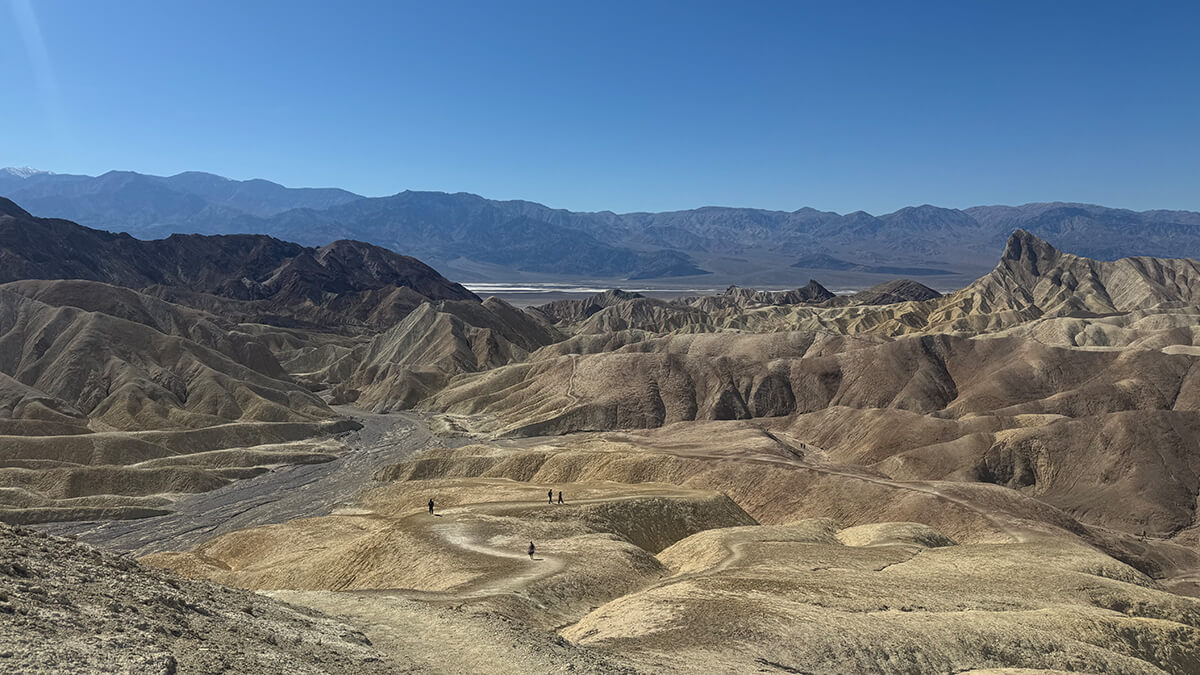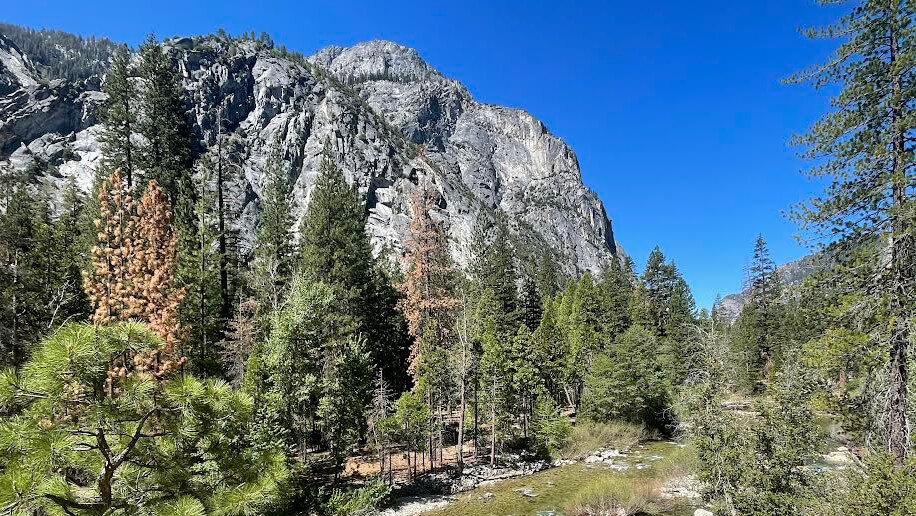Death Valley, Death Valley.
It has a very impactful name and is a vast desert area on the border between California and Nevada.
As the name suggests, once you put it in, you will be convinced that the name Death Valley was given to the endless wastelands, deserts, and the harsh environment, and the words disappear.
The name comes from the 1849 California Gold Rush when pioneers in search of gold accidentally wandered into the valley, falling into extreme conditions. The place name comes from a woman who said "Goodbye, Death Valley" at this time.
This is the lowest elevation in the United States. Badwater Basin in the park is about 86 meters above sea level, making it the lowest point in North America.
Furthermore, the famous Death Valley is also famous as the hottest place in America. Death Valley, let alone America, is officially the hottest place on the planet. Recorded on July 10th, 1913, 56.7 degrees Celsius (134 degrees Fahrenheit) is considered one of the highest temperatures in the world. In addition, recently, 54.4 degrees (130 degrees Fahrenheit) was observed in July 2021.
Death Valley can reach temperatures over 50 degrees every day in the summer, and is known worldwide as the "the most extreme heat location," and is said to be the best season for sightseeing and hiking from autumn until spring, October to April, and is dangerous after that. Be careful as it's too hot in the summer.
Starting from this time, we will introduce hiking information about Seinodani Park in three parts (I will share the history of Death Valley in my next post).
This time we'd like to introduce you to the Golden Canyon Trail Loop to Zabriskie Point, a recommended hike that allows you to enjoy the unique landscape of Death Valley.
table of contents
Recommended times for hiking in Death Valley
- October - April: The temperature is relatively calm, allowing you to enjoy sightseeing and hiking comfortably.
- December to February (Winter): It's easy to spend around 20°C during the day, but there are differences in temperature during the mornings and evenings. It gets cold in the mornings and evenings, so you need to take measures to keep you warm and be careful about your outfits.
- March to April (Spring): Wildflowers bloom, especially in rainy years, making it a beautiful time for beautiful scenery.
*Please be careful as Death Valley from May to September (summer) is one of the world's hottest heat, with a very high risk of heat stroke, and sightseeing and hiking are dangerous. If you are hiking between March and May, we recommend early morning or evening. Avoid hiking in the summer here.
Golden Canyon Trail Loop to Zabriskie Point Trail Information
Access (car to the trailhead)
Death Valley is located on the California-Nevada border, so it is usually convenient to go through Los Angeles (4 to 5 hours by car from LAX) or Las Vegas (2 to 2.5 hours by car from LAS) to Death Valley.
Trailhead Address: Golden Canyon Trailhead
Alternatively, you can find it by adding Badwater Rd, DEATH VALLEY, CA 92328 using Google Maps. *As the signal conditions are poor, we recommend downloading the map in advance.
What to bring
As before, make sure to prepare the same equipment as a typical American hike.
- Drinks (it's best to have a large 3 liters)
- Cold weather clothing that can adjust the temperature (wind-proof shells are useful)
- hat
- sunglasses
- Sunscreen
- Snacks and more for eating while hiking
- If you have a regular medicine, first aid such as medicine or band-aid
- Other things you prefer with your regular hiking equipment
Trail data
- For beginners and intermediate students
- Best seasons from October to April (This photo is from March).
- Round-trip distance: 9.6km (6mi)
- Elevation difference: Approximately 324m
- Trailhead elevation: Approx. 79 m
- Average hiking time: 2.5 and a half to 3.5 hours
Hiking begins at the trailhead (trailhead) (12:00 noon in early March)
The parking was busy, but there was free space at this time of lunchtime. Many groups walked back to nearby nearby places, so cars were frequently entered and left.
The bathrooms are also located here.
Starting at the trailhead. I think the temperature on this day was 24 degrees. It should have risen to about 27 degrees by the end of the hike.
This trail is looped so you can go around the clock and return to the same starting point.
The first thing to greet you is the rock wall
Perhaps because it was the best season, it was a weekday, but there were many people around the starting point. Incidentally, this trail is almost completely shaded and dry. Lol But at first it goes fairly flat and tidy.
Contrast of a blue blue sky and a flesh-tone rocky mountain. It's a sight you don't see in California.
If you go further, a fork will appear. (About 20 minutes after departure)
Head towards Zabriskie Point Trailhead, then head to the narrow road to the right.
The observation deck called Zabriskie Point will become today's half point, and we will head towards it first.
The directions are indicated by arrows on the trail, making it very easy to understand. A national park.
The ground has changed to white. The colour of the surrounding rocks and the colour of the ground continue to change.
It's already hot and hot. After 20 minutes of walking, I was already sweating. Hats, sunglasses and sunscreen are essential!
In the back, we saw a sharp, towering golden sandstone peak called the Manly Beacon. It is a very distinctive rock terrain. The slope also begins.
The name was named after William L. Manly, one of the pioneers who traveled across Death Valley during the 1849 California Gold Rush.
The climb continues towards this Manly Beacon.
This sight can only be seen up close by walking the trail, and is a privilege of hikers.
The trail further leads to the side of the sandstone peak, Manly Beacon.
Once we reached this point, we had quite a few climbs, so when we looked around, we could see snowy mountains in the back.
There is a little descent, then a second fork sign appears.
You can go from either way, but instead of via Gower Gulch, head left towards Zabriskie Point Trailhead.
It's like it's going to be in a movie like Star Wars or something, and it feels like it's lost on other planets. There are various strata formed by millions of years of deposition and erosion, and looking around, the different geology, mineral content, and the different coloured sandstones and rocky mountains created by the effects of weathering and oxidation will captivate us hikers as art in the desert.
If you continue further down the trail, you will see a third fork sign.
I also headed to the left to Zabriskie Point Trailhead, and finally made a little more effort to the Zabriskie Point observation deck.
The trail continues with the parking area of the Zabriskie Point Observation Deck.
The observation deck is located a little up the hill from the parking lot. Those who visit here will park their car and walk up this hill to see the view. At first glance, it may look like a long slope, but since it is lower than in other places, you won't be out of breath, and it's easy for those with good legs to go, so don't worry.
About an hour and a half after the start of the hike, we arrived at halfway point. Here's a little break.
Zabriskie Point
The view from here seems to be the compression of the ancient lake sediments, creating a unique wavy pattern and colour, and the observation deck here is a popular stop, even in Death Valley, as it has a spectacular view.
Due to the influence of volcanic activity, the Death Valley formations contain volcanic ash and lava from ancient volcanic eruptions, which harden to create specific colors (gray, black, etc.).
Due to the effects of climate and weathering, extreme temperature changes and wind erosion have changed the rock surface and strengthened the contrast of the colour. Indeed, other national parks, you can see the proof of nature that has been created over the years before your eyes.
Well, the hike continues. In fact, there is a continuing trail from Zabriskie Point. There is a trail on the right, just before the observation deck, and from here we head down to the second half of the game begins.
I continued downhill, looking over my head at Zabriskie Point, which I had been there a while ago, I walked down the valley floor.
The second half is very easy. Once you have descended to the bottom of the valley, the area will continue to be almost flat from there.
The scenery is as unique as ever, and although the surrounding area is only rocky mountains, you never get bored of it.
The hike ends at 2:35pm, about 2.5 hours after the start.
This trail is usually a hiking trail that can be enjoyed during the winter season, and is a place that even beginners can enjoy.
After all, it's a different atmosphere and charm from other national parks, making it an irresistible place for desert lovers.
Please come and visit Death Valley, which you can enjoy during the winter season.
to be continued
Kato Sayaka


